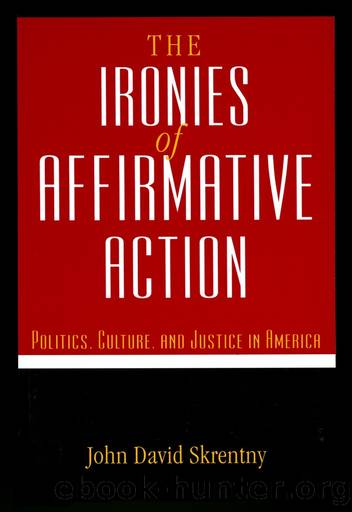The Ironies of Affirmative Action: Politics, Culture, and Justice in America by John David Skrentny

Author:John David Skrentny [Skrentny, John David]
Language: eng
Format: epub
Tags: Labor & Industrial Relations, Labor & Employment, Political Science, Law, General
ISBN: 9780226216423
Google: cw6BDwAAQBAJ
Goodreads: 1302159
Publisher: University of Chicago Press
Published: 1996-05-01T00:00:00+00:00
7
Creative Destruction in the Nixon Administration
Perhaps the greatest irony of all in the story of affirmative action is that this controversial model of justice owes its most advanced and explicit race-based formulation to a Republican president who based much of his campaign on appealing to the racially conservative South. This was, of course, the enigmatic Richard Nixon. Whereas President Johnson and his fellow Democrats had struggled mightily both to help blacks and to avoid giving this help a racial label, Nixon, for a time, rather proudly marched under a race-conscious banner. As we will see, for a Republican president in 1969, this was a perfectly sensible thing to do.
By 1969, a few years of crisis management, administrative pragmatism, and the continued advocacy of American traditions and precedents of justice and civil rights had done much to make different unit ideas of the affirmative action model legitimate parts of policy and legal discourse. Moral policy boundaries were blurring, and following the Kerner Report the risk of race-consciousness advocacy had declined somewhat. Even to the national audience, it lost its third-rail quality.
But the Left was not yet solidly behind any policy called affirmative action. While suggested in various parts and practices of civil rights enforcement and crisis management, affirmative action was not completely institutionalized in any specific policy. This was finally to occur on 27 June 1969 (and then again on 23 September, after surviving a legal challengeâand then again, on 22 December, after surviving a Congressional challenge), when the Nixon administration revived and shepherded past critics the Philadelphia Plan (henceforth, the Plan), the old race-conscious, affirmative action program for the construction industry. The Plan, as discussed in chapter 5, was pragmatically constructed by the OFCC during the Johnson administration and soon struck down by the comptroller general for being too ambiguous. In the Nixon version, designed to meet contracting requirements which state that guidelines for bids must be explicit, the affirmative action guidelines took the form of government-determined, numerically explicit percentages of minorities to be hired. Put simply, in the view of many observers, a Republican national government ordered racial quotas. Soon, however, Nixon repudiated them, but not until after civil rights groups and their Democratic supporters embraced this new tool, and paid the political costs for doing so. Legitimacy does not necessarily mean popularity.
Making Sense of Nixonâs Civil Rights Policy
Understanding the Nixon civil rights agenda has been an exercise in futility for scholars of the American presidencyâas well as for insiders in the Nixon White House. The tendency, especially on the Left, was to see Nixon as a villain and enemy of civil rights. After all, in some areas, most notably school desegregation, the Nixon administration did try to reverse the prevailing national policy. Even the moderate Roy Wilkins of the NAACP maintained that Nixon sought to âturn the clock back on everything,â and was on the side of âenemies of little black children.â1 In a 1973 collection of indignant indictments of âTricky Dick,â What Nixon Is Doing to Us,
Download
This site does not store any files on its server. We only index and link to content provided by other sites. Please contact the content providers to delete copyright contents if any and email us, we'll remove relevant links or contents immediately.
The Social Psychology of Inequality by Unknown(2937)
The Plant Paradox by Dr. Steven R. Gundry M.D(2545)
The Writing on the Wall by Anselm Jappe(2010)
Working for Yourself by J.D. (Nolo) Stephen Fishman(1815)
Every Landlord's Legal Guide by Janet Portman & Stewart Marcia & Ralph Warner(1628)
The First 20 Hours: How to Learn Anything ... Fast by Kaufman Josh(1618)
ADHD on Trial by Michael Gordon(1531)
Decisive by Chip Heath(1514)
Working for Yourself by Stephen Fishman J.D. (Nolo)(1479)
Drafting Contracts: How and Why Lawyers Do What They Do, Second Edition by Stark Tina L(1456)
A Practical Guide to International Arbitration in London by Hilary Heilbron(1395)
Restitution by Restitution(1393)
Intellectual Property Strategy by John Palfrey(1385)
The Economist Aug 8th 2015 by The Economist(1384)
The Lord of the Rings: The Fellowship of the Ring, the Two Towers, the Return of the King by J. R. R. Tolkien(1382)
Get What's Yours for Medicare by Philip Moeller(1367)
The Economist Aug 29th 2015 by The Economist(1343)
Collusion by Luke Harding(1282)
Persuasion by Owner(1266)
